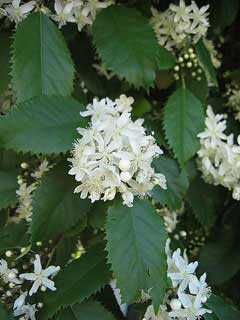 |
|
http://commons.wikimedia.org/wiki/File:Hoheria_populnea_lanceolata_146-8843.jpg |
 |
| http://commons.wikimedia.org/wiki/User:Avenue |
Translate this page:
Summary
Physical Characteristics

 Hoheria populnea is an evergreen Tree growing to 5 m (16ft) by 5 m (16ft) at a medium rate.
Hoheria populnea is an evergreen Tree growing to 5 m (16ft) by 5 m (16ft) at a medium rate.
See above for USDA hardiness. It is hardy to UK zone 8 and is frost tender. It is in leaf all year, in flower from August to September. The species is hermaphrodite (has both male and female organs) and is pollinated by Bees.
It is noted for attracting wildlife.
Suitable for: light (sandy), medium (loamy) and heavy (clay) soils and prefers well-drained soil. Suitable pH: mildly acid, neutral and basic (mildly alkaline) soils and can grow in very acid and very alkaline soils.
It can grow in semi-shade (light woodland) or no shade. It prefers moist soil. The plant can tolerate maritime exposure.
UK Hardiness Map
US Hardiness Map
Synonyms
Plant Habitats
Woodland Garden Secondary; Sunny Edge; Dappled Shade;
Edible Uses
References More on Edible Uses
Medicinal Uses
Plants For A Future can not take any responsibility for any adverse effects from the use of plants. Always seek advice from a professional before using a plant medicinally.
Demulcent Ophthalmic
Demulcent, ophthalmic[61].
References More on Medicinal Uses
The Bookshop: Edible Plant Books
Our Latest books on Perennial Plants For Food Forests and Permaculture Gardens in paperback or digital formats.

Edible Tropical Plants
Food Forest Plants for Hotter Conditions: 250+ Plants For Tropical Food Forests & Permaculture Gardens.
More

Edible Temperate Plants
Plants for Your Food Forest: 500 Plants for Temperate Food Forests & Permaculture Gardens.
More

More Books
PFAF have eight books available in paperback and digital formats. Browse the shop for more information.
Shop Now
Other Uses
Fibre Fuel Wood
A very strong fibre is obtained from the inner bark[128]. It is used for making ropes, cord etc[46, 61]. The fibre is also used as ornamentation in basket making and for bonnets etc[128]. Wood - white, very tough. Used by cabinet makers, it also makes an excellent fuel[128].
Special Uses
Attracts Wildlife
References More on Other Uses
Cultivation details
Grows in any good, well-drained soil[1]. Requires a position in full sun[182] or dappled shade[200], succeeding in acid or alkaline soils[182]. Plants grown in a soil that is overly rich produce a lot of sappy growth that is more susceptible to frost damage[200]. Withstands strong winds but is best if given protection from cold north-easterly winds[200]. Another report says that it requires a position sheltered from strong winds[125]. Prefers a moist atmosphere[125]. Prefers a maritime climate[200]. Plants grow best in an open clearing in a woodland garden[200]. A very ornamental plant[1], it is only hardy in the milder areas of the country[1, 11, 49], tolerating temperatures down to about -10°c[182]. Plants are prone to damage at temperatures lower than -5°c[200]. A very variable plant[11], leaves of young plants are often deeply lobed but on older plants they are more or less entire and toothed[126, 182]. Juvenile plants also have a compact shrubby habit, quite unlike the mature plant[200]. There are some named forms selected for their ornamental value[219]. Plants are subject to attacks by the coral-spot fungus, especially after cool wet summers[126]. Plants in this genus are notably resistant to honey fungus[200]. A good butterfly plant[200].
References Carbon Farming Information and Carbon Sequestration Information
Temperature Converter
Type a value in the Celsius field to convert the value to Fahrenheit:
Fahrenheit:
The PFAF Bookshop
Plants For A Future have a number of books available in paperback and digital form. Book titles include Edible Plants, Edible Perennials, Edible Trees,Edible Shrubs, Woodland Gardening, and Temperate Food Forest Plants. Our new book is Food Forest Plants For Hotter Conditions (Tropical and Sub-Tropical).
Shop Now
Plant Propagation
Seed - sow autumn in a greenhouse. It usually germinates freely[200]. When they are large enough to handle, prick the seedlings out into individual pots and grow them on in the greenhouse for at least their first winter. Plant them out into their permanent positions in late spring or early summer, after the last expected frosts. Cuttings of half-ripe wood, 7 - 10cm with a heel, July/August in a shady position in a frame. The cuttings should be put in 12cm pots. A fair to good percentage[78]. Layering in April. Takes 12 months[78].
Other Names
If available other names are mentioned here
Native Range
AUSTRALASIA: New Zealand
Weed Potential
Right plant wrong place. We are currently updating this section.
Please note that a plant may be invasive in one area but may not in your area so it's worth checking.
Conservation Status
IUCN Red List of Threatened Plants Status :

Growth: S = slow M = medium F = fast. Soil: L = light (sandy) M = medium H = heavy (clay). pH: A = acid N = neutral B = basic (alkaline). Shade: F = full shade S = semi-shade N = no shade. Moisture: D = dry M = Moist We = wet Wa = water.
Now available:
Food Forest Plants for Mediterranean Conditions
350+ Perennial Plants For Mediterranean and Drier Food Forests and Permaculture Gardens.
[Paperback and eBook]
This is the third in Plants For A Future's series of plant guides for food forests tailored to
specific climate zones. Following volumes on temperate and tropical ecosystems, this book focuses
on species suited to Mediterranean conditions—regions with hot, dry summers and cool, wet winters,
often facing the added challenge of climate change.
Read More
Expert comment
Author
A.Cunn.
Botanical References
1144200
Links / References
For a list of references used on this page please go here
Readers comment
© 2010, Plants For A Future. Plants For A Future is a charitable company limited by guarantee, registered in England and Wales. Charity No. 1057719, Company No. 3204567.